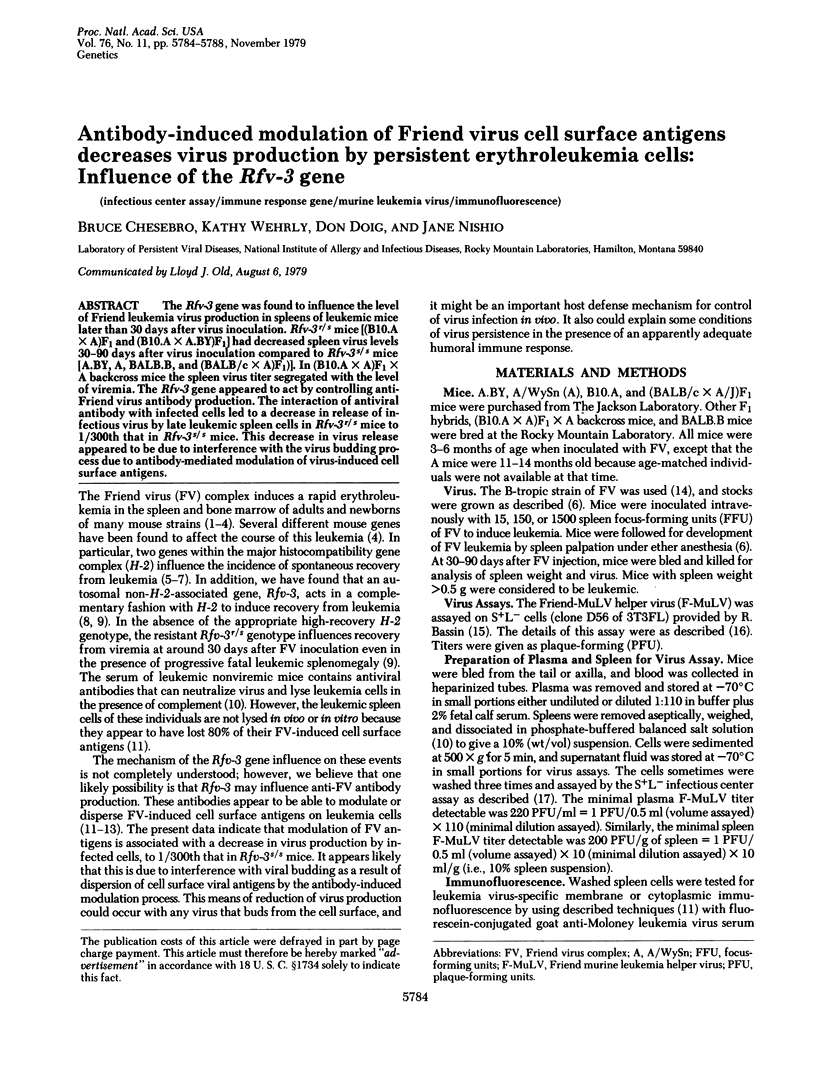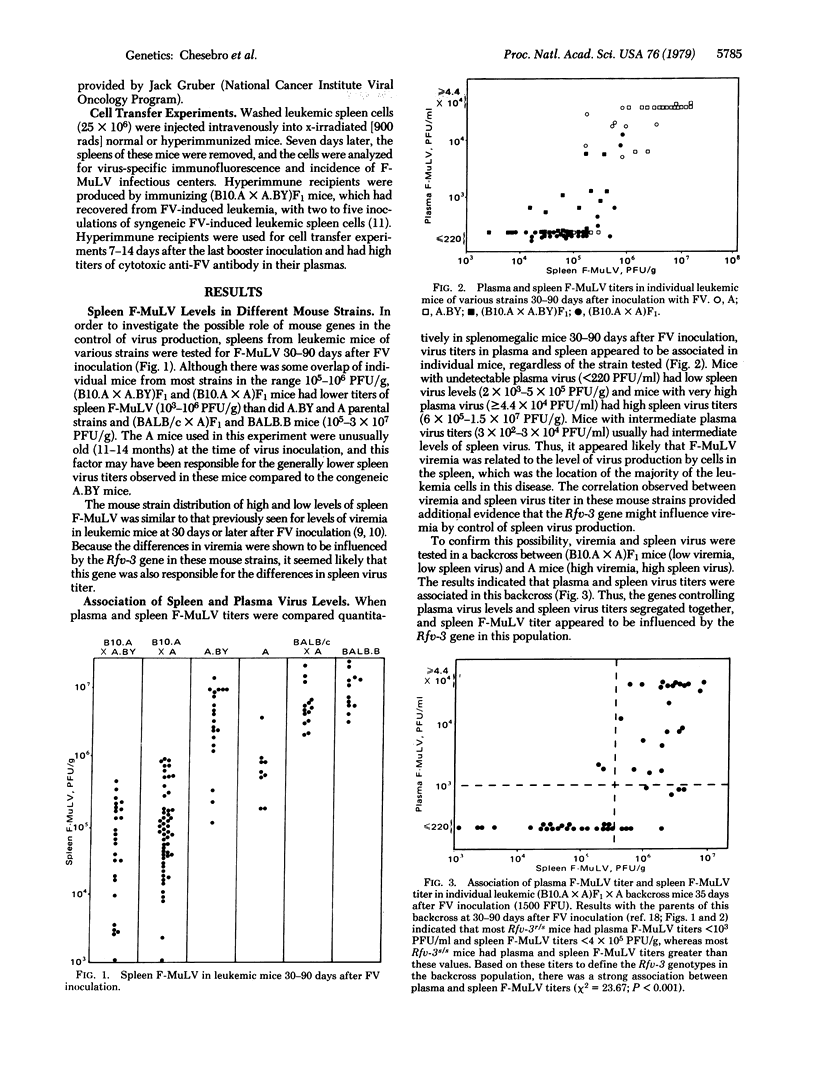Abstract
The Rfv-3 gene was found to influence the level of Friend leukemia virus production in spleens of leukemic mice later than 30 days after virus inoculation. Rfv-3r/s mice [(B10.A X A)F1 and (B10.A X A.BY)F1] had decreased spleen virus levels 30-90 days after virus inoculation compared to Rfv-3s/s mice [A.BY, A, BALB.B, and (BALB/c X A)F1)]. In (B10.A X A)F1 X A backcross mice the spleen virus titer segregated with the level of viremia. The Rfv-3 gene appeared to act by controlling anti-Friend virus antibody production. The interaction of antiviral antibody with infected cells led to a decrease in release of infectious virus by late leukemic spleen cells in Rfv-3r/s mice to 1/300th that in Rfv-3s/s mice. This decrease in virus release appeared to be due to interference with the virus budding process due to antibody-mediated modulation of virus-induced cell surface antigens.
Full text
PDF




Selected References
These references are in PubMed. This may not be the complete list of references from this article.
- Aoki T., Johnson P. A. Suppression of Gross leukemia cell-surface antigens: a kind of antigenic modulation. J Natl Cancer Inst. 1972 Jul;49(1):183–192. [PubMed] [Google Scholar]
- Bassin R. H., Tuttle N., Fischinger P. J. Rapid cell culture assay technic for murine leukaemia viruses. Nature. 1971 Feb 19;229(5286):564–566. doi: 10.1038/229564b0. [DOI] [PubMed] [Google Scholar]
- Boyse E. A., Stockert E., Old L. J. Modification of the antigenic structure of the cell membrane by thymus-leukemia (TL) antibody. Proc Natl Acad Sci U S A. 1967 Sep;58(3):954–957. doi: 10.1073/pnas.58.3.954. [DOI] [PMC free article] [PubMed] [Google Scholar]
- Brecht H., Hämmerling U., Rott R. Undisturbed release of influenza virus in the presence of univalent antineuraminidase antibodies. Virology. 1971 Nov;46(2):337–343. doi: 10.1016/0042-6822(71)90035-3. [DOI] [PubMed] [Google Scholar]
- Calafat J., Hilgers J., Van Bitterswijk W. J., Verbeet M., Hageman P. C. Antibody-induced modulation and shedding of mammary tumor virus antigens on the surfaces of GR ascites leukemia cells as compared with normal antigens. J Natl Cancer Inst. 1976 May;56(5):1019–1029. doi: 10.1093/jnci/56.5.1019. [DOI] [PubMed] [Google Scholar]
- Chesebro B., Wehrly K., Chesebro K., Portis J. Characterization of Ia8 antigen, thy-1.2 antigen, complement receptors, and virus production in a group of murine virus-induced leukemia cell lines. J Immunol. 1976 Oct;117(4):1267–1274. [PubMed] [Google Scholar]
- Chesebro B., Wehrly K. Identification of a non-H-2 gene (Rfv-3) influencing recovery from viremia and leukemia induced by Friend virus complex. Proc Natl Acad Sci U S A. 1979 Jan;76(1):425–429. doi: 10.1073/pnas.76.1.425. [DOI] [PMC free article] [PubMed] [Google Scholar]
- Chesebro B., Wehrly K. Rfv-1 and Rfv-2, two H-2-associated genes that influence recovery from Friend leukemia virus-induced splenomegaly. J Immunol. 1978 Apr;120(4):1081–1085. [PubMed] [Google Scholar]
- Chesebro B., Wehrly K., Stimpfling J. Host genetic control of recovery from Friend leukemia virus-induced splenomegaly: mapping of a gene within the major histocompatability complex. J Exp Med. 1974 Dec 1;140(6):1457–1467. doi: 10.1084/jem.140.6.1457. [DOI] [PMC free article] [PubMed] [Google Scholar]
- Chesebro B., Wehrly K. Studies on the role of the host immune response in recovery from Friend virus leukemia. I. Antiviral and antileukemia cell antibodies. J Exp Med. 1976 Jan 1;143(1):73–84. doi: 10.1084/jem.143.1.73. [DOI] [PMC free article] [PubMed] [Google Scholar]
- Chesebro B., Wehrly K. Studies on the role of the host immune response in recovery from Friend virus leukemia. II. Cell-mediated immunity. J Exp Med. 1976 Jan 1;143(1):85–99. doi: 10.1084/jem.143.1.85. [DOI] [PMC free article] [PubMed] [Google Scholar]
- Chesebro B., Wehrly K., Watson K., Chesebro K. Murine leukemia virus infectious centers are dependent on the rate of virus production by infected cells. Virology. 1978 Jan;84(1):222–226. doi: 10.1016/0042-6822(78)90239-8. [DOI] [PubMed] [Google Scholar]
- Doig D., Chesebro B. Anti-Friend virus antibody is associated with recovery from viremia and loss of viral leukemia cell-surface antigens in leukemic mice. Identification of Rfv-3 as a gene locus influencing antibody production. J Exp Med. 1979 Jul 1;150(1):10–19. doi: 10.1084/jem.150.1.10. [DOI] [PMC free article] [PubMed] [Google Scholar]
- Doig D., Chesebro B. Antibody-induced loss of Friend virus leukemia cell surface antigens occurs during progression of erythroleukemia in F1 mice. J Exp Med. 1978 Nov 1;148(5):1109–1121. doi: 10.1084/jem.148.5.1109. [DOI] [PMC free article] [PubMed] [Google Scholar]
- Dowdle W. R., Downie J. C., Laver W. G. Inhibition of virus release by antibodies to surface antigens of influenza viruses. J Virol. 1974 Feb;13(2):269–275. doi: 10.1128/jvi.13.2.269-275.1974. [DOI] [PMC free article] [PubMed] [Google Scholar]
- Driscoll D. M., Onuma M., Olson C. Inhibition of bovine leukemia virus release by antiviral antibodies. Arch Virol. 1977;55(1-2):139–144. doi: 10.1007/BF01314487. [DOI] [PubMed] [Google Scholar]
- FRIEND C. Cell-free transmission in adult Swiss mice of a disease having the character of a leukemia. J Exp Med. 1957 Apr 1;105(4):307–318. doi: 10.1084/jem.105.4.307. [DOI] [PMC free article] [PubMed] [Google Scholar]
- Friend C., Patuleia M. C., De Harven E. Erythrocytic maturation in vitro of murine (Friend) virus-induced leukemic cells. Natl Cancer Inst Monogr. 1966 Sep;22:505–522. [PubMed] [Google Scholar]
- Genovesi E. V., Marx P. A., Wheelock E. F. Antigenic modulation of Friend virus erythroleukemic cells in vitro by serum from mice with dormant erythroleukemia. J Exp Med. 1977 Aug 1;146(2):520–534. doi: 10.1084/jem.146.2.520. [DOI] [PMC free article] [PubMed] [Google Scholar]
- Hall W. W., Kiessling W., ter Meulen V. Membrane proteins of subacute sclerosing panencephalitis and measles viruses. Nature. 1978 Mar 30;272(5652):460–462. doi: 10.1038/272460a0. [DOI] [PubMed] [Google Scholar]
- Ioachim H. L., Sabbath M. Redistribution and modulation of Gross murine leukemia virus antigens induced by specific antibodies. J Natl Cancer Inst. 1979 Jan;62(1):169–180. [PubMed] [Google Scholar]
- Joseph B. S., Oldstone M. B. Antibody-induced redistribution of measles virus antigens on the cell surface. J Immunol. 1974 Oct;113(4):1205–1209. [PubMed] [Google Scholar]
- Joseph B. S., Oldstone M. B. Immunologic injury in measles virus infection. II. Suppression of immune injury through antigenic modulation. J Exp Med. 1975 Oct 1;142(4):864–876. doi: 10.1084/jem.142.4.864. [DOI] [PMC free article] [PubMed] [Google Scholar]
- Kono Y., Kobayashi K., Fukunaga Y. Antigenic drift of equine infectious anemia virus in chronically infected horses. Arch Gesamte Virusforsch. 1973;41(1):1–10. doi: 10.1007/BF01249923. [DOI] [PubMed] [Google Scholar]
- Ledbetter J., Nowinski R. C., Emery S. Viral proteins expressed on the surface of murine leukemia cells. J Virol. 1977 Apr;22(1):65–73. doi: 10.1128/jvi.22.1.65-73.1977. [DOI] [PMC free article] [PubMed] [Google Scholar]
- Lilly F., Steeves R. A. B-tropic Friend virus: a host-range pseudotype of spleen focus-forming virus (SFFV). Virology. 1973 Oct;55(2):363–370. doi: 10.1016/0042-6822(73)90176-1. [DOI] [PubMed] [Google Scholar]
- Lilly F. The effect of histocompatibility-2 type on response to friend leukemia virus in mice. J Exp Med. 1968 Mar 1;127(3):465–473. doi: 10.1084/jem.127.3.465. [DOI] [PMC free article] [PubMed] [Google Scholar]
- Loor F., Forni L., Pernis B. The dynamic state of the lymphocyte membrane. Factors affecting the distribution and turnover of surface immunoglobulins. Eur J Immunol. 1972 Jun;2(3):203–212. doi: 10.1002/eji.1830020304. [DOI] [PubMed] [Google Scholar]
- METCALF D., FURTH J., BUFFETT R. F. Pathogenesis of mouse leukemia caused by Friend virus. Cancer Res. 1959 Jan;19(1):52–58. [PubMed] [Google Scholar]
- Narayan O., Griffin D. E., Chase J. Antigenic shift of visna virus in persistently infected sheep. Science. 1977 Jul 22;197(4301):376–378. doi: 10.1126/science.195339. [DOI] [PubMed] [Google Scholar]
- Old L. J., Stockert E., Boyse E. A., Kim J. H. Antigenic modulation. Loss of TL antigen from cells exposed to TL antibody. Study of the phenomenon in vitro. J Exp Med. 1968 Mar 1;127(3):523–539. doi: 10.1084/jem.127.3.523. [DOI] [PMC free article] [PubMed] [Google Scholar]
- Rustigian R. Persistent infection of cells in culture by measles virus. II. Effect of measles antibody on persistently infected HeLa sublines and recovery of a HeLa clonal line persistently infected with incomplete virus. J Bacteriol. 1966 Dec;92(6):1805–1811. doi: 10.1128/jb.92.6.1805-1811.1966. [DOI] [PMC free article] [PubMed] [Google Scholar]
- Skinner G. R., Mushi E. Z., Whitney J. E. Immune inhibition of virus release from herpes simplex virus-infected cells. Intervirology. 1975;6(4-5):296–308. doi: 10.1159/000149483. [DOI] [PubMed] [Google Scholar]
- Stackpole C. W., Jacobson J. B., Lardis M. P. Antigenic modulation in vitro. I. Fate of thymus-leukemia (TL) antigen-antibody complexes following modulation of TL antigenicity from the surfaces of mouse leukemia cells and thymocytes. J Exp Med. 1974 Oct 1;140(4):939–953. doi: 10.1084/jem.140.4.939. [DOI] [PMC free article] [PubMed] [Google Scholar]
- Wechsler S. L., Fields B. N. Differences between the intracellular polypeptides of measles and subacute sclerosing panencephalitis virus. Nature. 1978 Mar 30;272(5652):458–460. doi: 10.1038/272458a0. [DOI] [PubMed] [Google Scholar]
- Witte O. N., Tsukamoto-Adey A., Weissman I. L. Cellular maturation of oncornavirus glycoproteins: topological arrangement of precursor and product forms in cellular membranes. Virology. 1977 Feb;76(2):539–553. doi: 10.1016/0042-6822(77)90236-7. [DOI] [PubMed] [Google Scholar]
- Witte O. N., Weissman I. L. Oncornavirus budding: kinetics of formation and utilization of viral membrane glycoprotein. Virology. 1976 Feb;69(2):464–473. doi: 10.1016/0042-6822(76)90477-3. [DOI] [PubMed] [Google Scholar]


